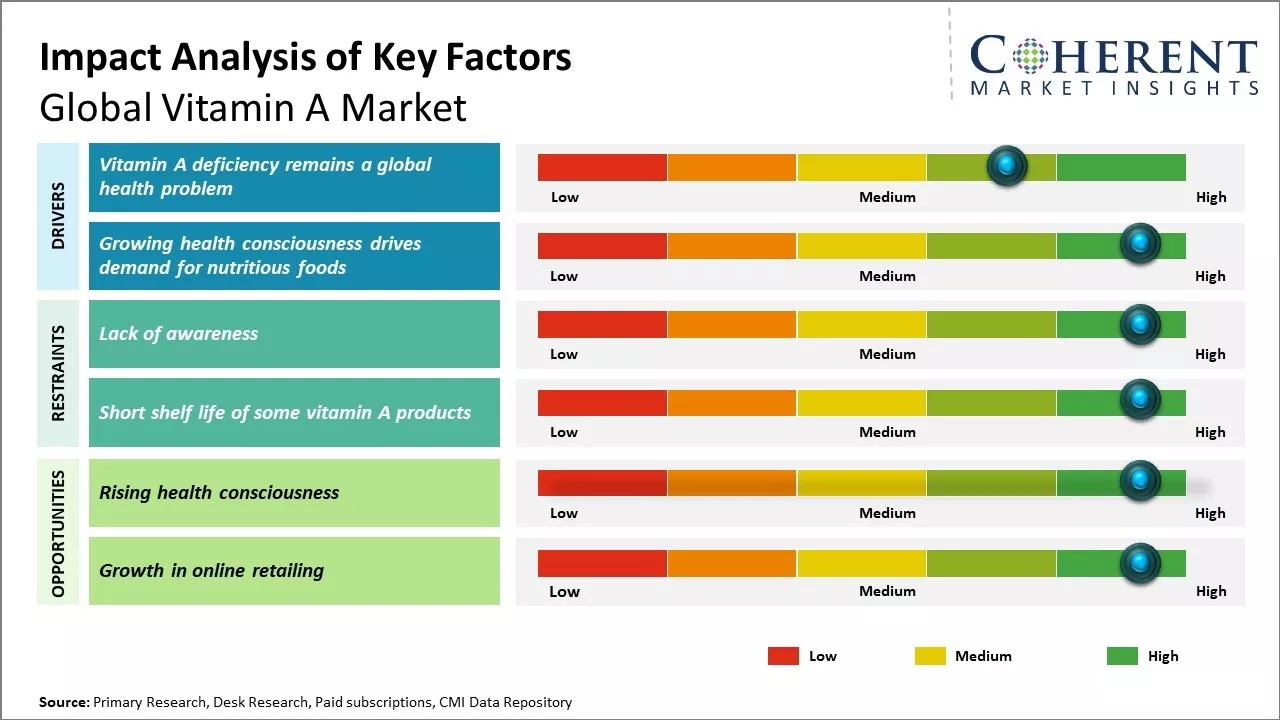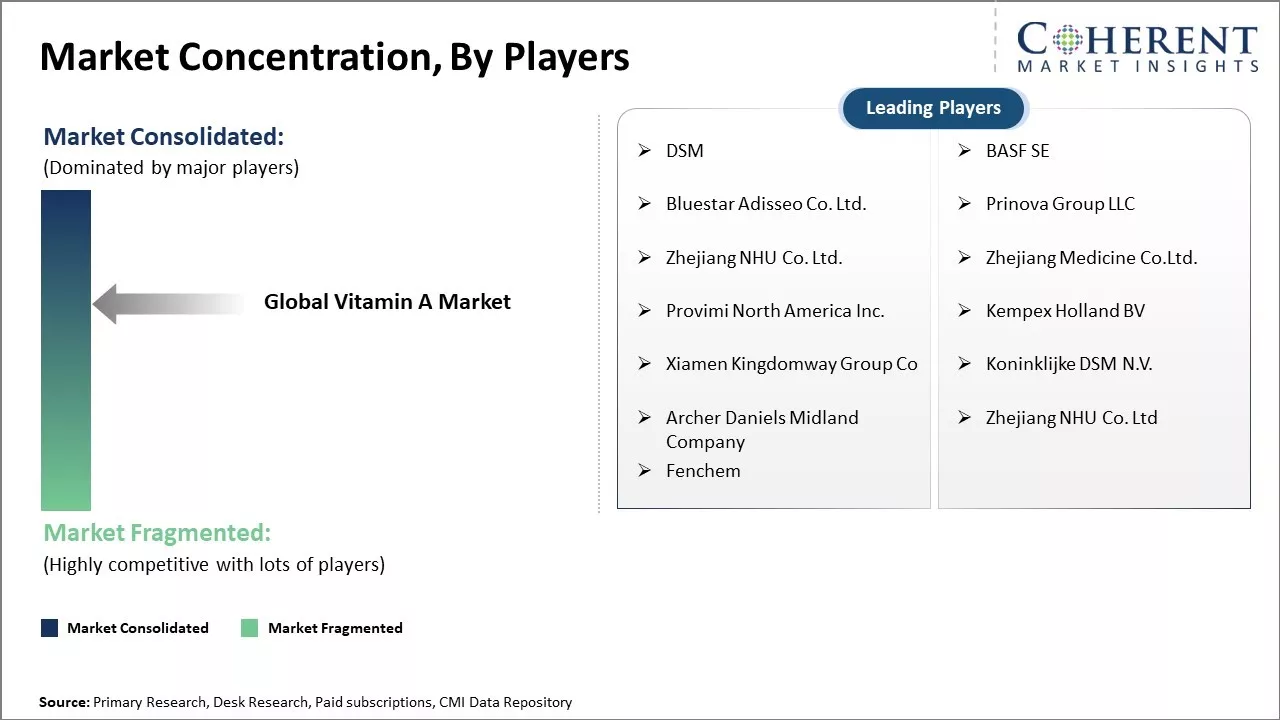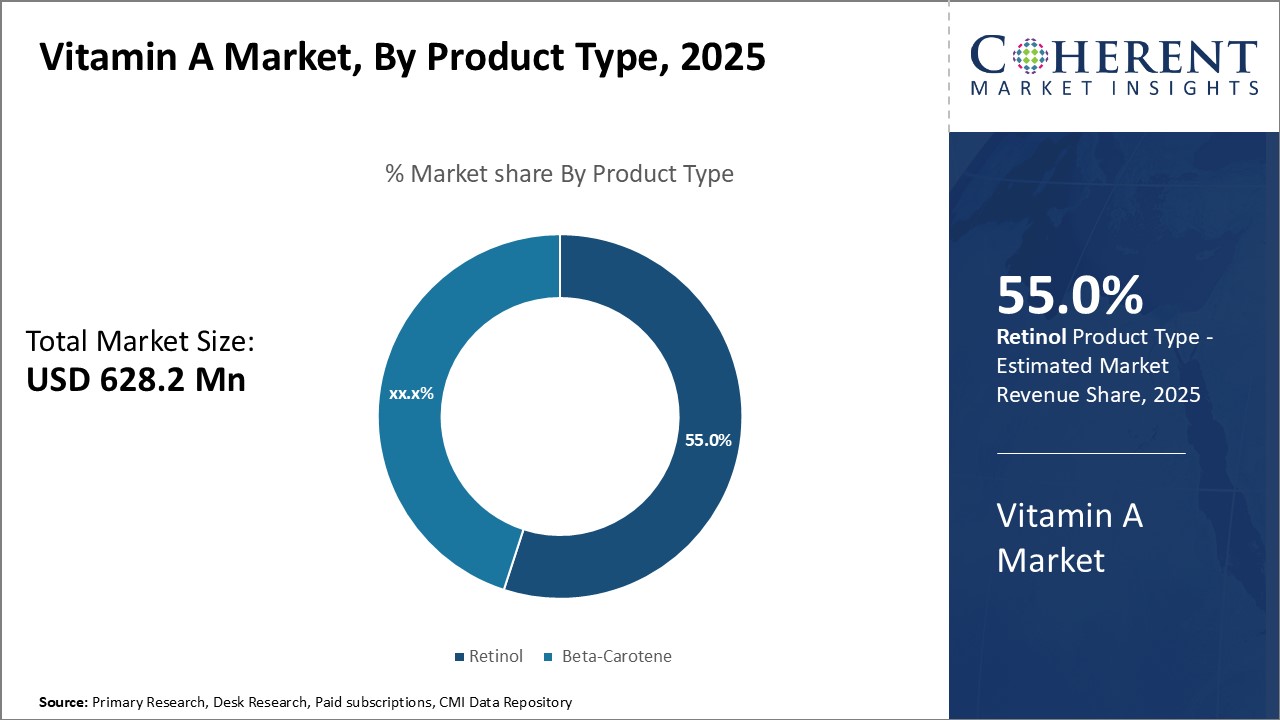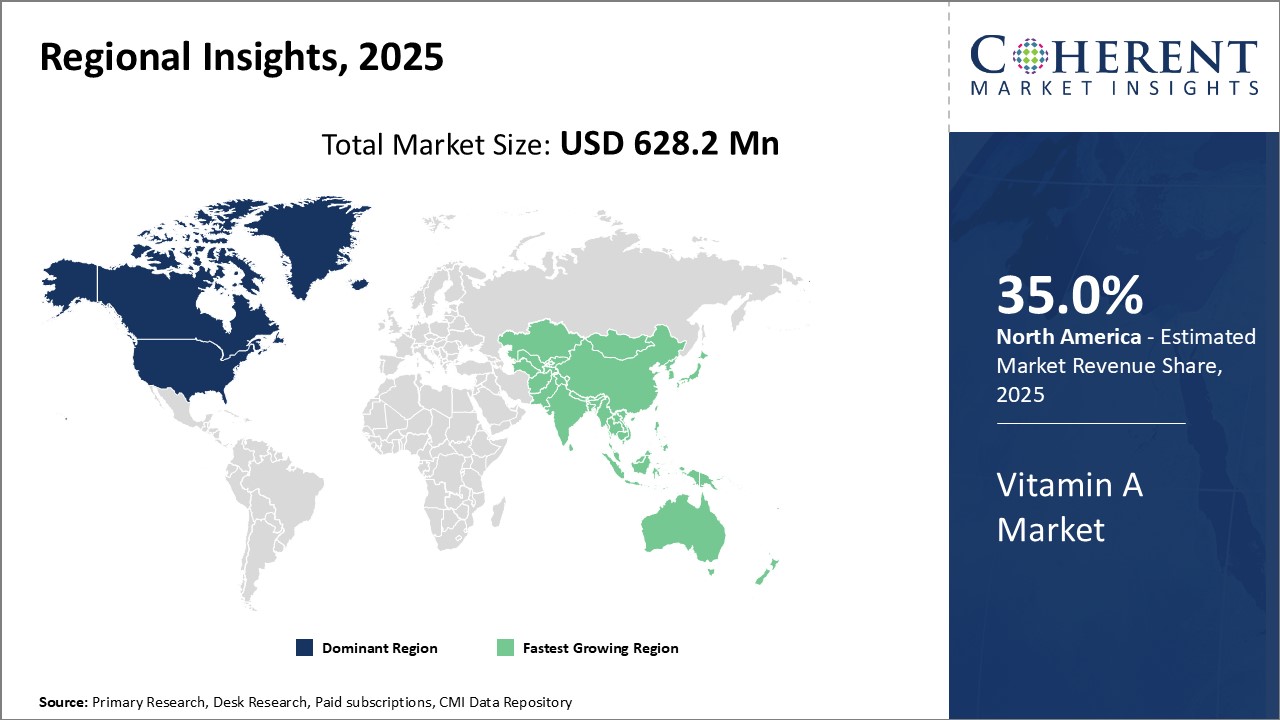The vitamin A market is estimated to be valued at USD 628.2 Mn in 2025 and is expected to reach USD 902.3 Mn by 2032, exhibiting a compound annual growth rate (CAGR) of 5.3% from 2025 to 2032.

Discover market dynamics shaping the industry: Download Free Sample
The demand for vitamin A is driven by its therapeutic applications in treating various health conditions, such as macular degeneration, and its use as a supplement. The vitamin A market is expected to witness steady growth over the forecast period. This can be attributed to rising health consciousness among consumers and growing prevalence of vitamin A deficiency. Furthermore, increasing utilization of vitamin A in skin and hair care products will support the market expansion. However, easy availability of substitute products may hinder the market growth to some extent over the coming years.
Drivers of the Market:
Vitamin A deficiency remains a global health problem
There remains a significant portion of the global population dealing with vitamin A deficiency. According to estimates from the World Health Organization and UNICEF, approximately 19 million pregnant women and 190 million preschool-aged children are affected by vitamin A deficiency. The consequences of inadequate vitamin A intake can be severe, especially for young children and pregnant mothers. A lack of vitamin A can weaken the immune system and increase the risk of infections like measles. It is also a leading cause of preventable blindness among children. Regions like sub-Saharan Africa and South Asia tend to have higher rates of vitamin A deficiency due to poverty, malnutrition, and insufficient dietary diversity. Public health efforts have made progress over the years in reducing deficiency rates through supplementation programs. However, achieving adequate vitamin A intake solely through diet remains a challenge in developing nations where staple crops may be low in this essential vitamin and nutrient. As long as vitamin A deficiency persists as a threat to health worldwide, demand will exist for supplements and fortified foods enriched with this important micronutrient.

Get actionable strategies to beat competition: Download Free Sample
Growing health consciousness drives demand for nutritious foods
In recent decades, populations around the world have been gaining a greater appreciation for how diet and nutrition impact health and well-being. With easy access to online health information, consumers are more knowledgeable than ever about the role vitamins, minerals, and other micronutrients play in promoting health and reducing disease risk. As incomes rise in emerging economies, people are also able to devote more disposable spending towards nutritious, high-quality food products. The paradigm is gradually shifting away from a focus purely on calories and towards the nutrient density of foods. In developed nations, an aging population concerned with chronic disease prevention and longevity is driving the demand for fortified, supplemented, and functional foods containing antioxidants and immune-supporting ingredients. There is fueling interest in value-added products offering specific health benefits beyond basic sustenance. Manufacturers have responded with a wide variety of fortified foods, supplements, and nutraceuticals targeted at nutrition-conscious consumers. As the association between good nutrition and health outcomes stays top-of-mind for shoppers, the demand is likely to continue increasing for accessible, convenient ways to intake important micronutrients like vitamin A through dietary modifications and supplements.
Key Takeaways from Analyst:
As incomes rise worldwide, more consumers are seeking nutrition and health supplements to supplement their diets. In addition, growing health awareness driven by online content is increasing the demand for micro-nutrients such as vitamin A. However, supply chain disruptions due to the ongoing pandemic and constraints on raw material procurement could hamper shorter term profitability for players in this market.
North America currently dominates the vitamin A market due to high supplement consumption levels and the presence of several leading global players. However, Asia Pacific is expected to witness the fastest growth during the forecast period. Rapid economic development, rising incomes, and growing health awareness are driving the sales of nutritional supplements in the region's largest markets such as India and China. Overall growth will also be supported by growing food & beverage fortification programs to address vitamin A deficiency across emerging nations.
Players need to innovate and introduce new delivery formats such as gummies and candies to appeal to more consumers. Focusing on herbal and natural sources of vitamin A through investments in sustainable extraction processes can strengthen the market positioning. Partnerships with leading e-commerce and offline retail platforms will also help extend reach into newer customer segments.
Market Challenges: Lack of awareness
One of the key challenges facing the vitamin A market is the lack of awareness about the importance and benefits of vitamin A among consumers. While vitamin A deficiency is a major public health problem globally, especially in developing countries, many people are still unaware of the vital role that vitamin A plays in boosting vision, immune function, and cell growth. Educational levels and access to healthcare information tends to be relatively lower in regions with high prevalence of vitamin A deficiency. This lack of awareness impacts the demand for vitamin A supplements and fortified foods. Even where supplements are provided through public health programs, awareness is needed for long-term compliance and behavior change. Educational campaigns have not been sufficiently effective in reaching all target groups and locations. Overcoming these information gaps through innovative community outreach and digital health education can help address this pressing challenge to the growth of the vitamin A market.
Market Opportunities: Rising health consciousness
Growing health consciousness among consumers around the world presents a major opportunity for the vitamin A market to expand. In recent years, people have become increasingly aware of the links between nutrition, diet, and overall well-being. As a result, there is a rising demand for supplements and fortified foods that provide important vitamins and minerals. Vitamin A, due its essential role in vision, growth and immunity, can benefit significantly from this consumer trend. Market players need to position vitamin A products as an essential component of a balanced diet and healthy lifestyle. They must promote its benefits through appropriate messaging on product packaging and online marketing campaigns. Entering new geographies and demographics will also allow the market to tap into populations that are embracing preventive healthcare through their diet.

Discover high revenue pocket segments and roadmap to it: Download Free Sample
Insights by product type: Rising Demand for Nutritive Foods Drives the Retinol Segment Growth
Retinol is expected to contribute 55.0% share of the vitamin A market in 2025, due to growing health-consciousness. Retinol, also known as preformed vitamin A, provides numerous health benefits when consumed in proper amounts. It plays a key role in vision, cell growth and differentiation, and maintains skin and mucosa health. The human body cannot produce retinol on its own and must obtain it through dietary sources like liver, fish oils, eggs and dairy products.
In recent years, consumers have become increasingly aware of the importance of obtaining essential vitamins and nutrients through their diets. As people seek to bolster their immunity and prevent chronic diseases, demand has risen for nutritious whole foods containing vitamins like retinol. Dairy producers have responded by fortifying milk and yogurt with retinol to attract health-focused buyers. Supplement manufacturers also formulate gummy, softgel, and pill formats with vitamin A in the form of retinol to appeal to those wishing to supplement their diets. At the same time, busy lifestyles lead many to consume more convenient processed and packaged foods. Food companies invest in retinol enrichment to maintain the nutritional value of products subjected to cooking processes which can degrade heat-labile vitamins. The growing proportion of working women has stimulated demand for ready-to-eat meals that maintain good nutrition. Retinol stability allows it to be easily incorporated into shelf-stable and microwaveable items.
Insights by application: Food Applications Dominate Wide Usage in Dietary Staples
Based on application, food and beverages is expected to claim 45.9% of the market share in 2025, owing to its broad inclusion across dietary staples. Food producers commonly fortify standard grocery items with beta-carotene or retinol to restore quantities lost during processing without altering taste or texture. Widely consumed breakfast cereals, breads, desserts and seasonings all represent delivery vehicles optimized for efficient micronutrient transfer.
Global dietary trends also spur food applications. As diets westernize in developing regions, daily caloric intake concentrates around convenient, mass-produced victuals. Manufacturers respond through fortification to ensure nutrition amid lifestyle changes. Simultaneously, many cultures traditionally obtain vitamin A through plant sources in curries, soups, and vegetable dishes. Food applications allow uniform supplementation replicating customary dietary patterns. Government health initiatives additionally fuel this segment. National programs promote vitamin A intake to reduce deficiencies threatening public health. Large-scale fortification forms a powerful preventative strategy, benefitting young families and financially vulnerable groups reliant on affordable supermarket options. Regulations mandate the enrichment of staple grains, vegetable oils, and condiments precisely because of their broad, equitable reach within populations.

Need a Different Region or Segment? Download Free Sample
North America represents the largest and most developed regional market for vitamin A globally. The region is expected to account for 35.0% of the market share in 2025. The presence of robust healthcare infrastructure and widespread consumer awareness about health and nutrition have supported the demand for vitamin A supplements in the region over the years. Countries such as the U.S and Canada have seen rising adoption of preventive healthcare approaches and proactive measures to address vitamin deficiencies, driving considerable uptake of vitamin A fortified foods and beverages. Easy availability of vitamin A through OTC channels and diverse product portfolios offered by key players have further facilitated widespread consumption. Leading supplement companies have also focused on innovative offerings such as gummies and soft gels targeting the growing health-conscious demographic. Stringent regulations regarding the usage of synthetic vitamin A in food items are expected to drive clean-label products in the coming years.
The vitamin A market in Asia Pacific has been witnessing rapid expansion, driven by robust economic growth and increasing health expenditures over the past decade. Countries like Indonesia, Thailand, and Malaysia have emerged as highly lucrative markets, characterized by rising per capita incomes, burgeoning middle-class populations and their increasing willingness to spend on nutrition and wellness. Local manufacturers have augmented production and strengthened distribution networks to satisfy this emerging demand. Being a major producer and exporter of palm oil globally, the region has leveraged its agricultural strengths to emerge as a key supplier of natural vitamin A to international players as well. Supportive government policies promoting micronutrient fortification initiatives have provided a further boost to market stakeholders. Overall, Asia Pacific represents one of the fastest-growing geographical markets for vitamin A globally.
Vitamin A Market Report Coverage
| Report Coverage | Details | ||
|---|---|---|---|
| Base Year: | 2024 | Market Size in 2025: | USD 628.2 Mn |
| Historical Data for: | 2020 To 2024 | Forecast Period: | 2025 To 2032 |
| Forecast Period 2025 to 2032 CAGR: | 5.3% | 2032 Value Projection: | USD 902.3 Mn |
| Geographies covered: |
|
||
| Segments covered: |
|
||
| Companies covered: |
DSM, BASF SE, Bluestar Adisseo Co. Ltd., Prinova Group LLC, Zhejiang NHU Co. Ltd., Zhejiang Medicine Co.Ltd., Provimi North America Inc., Kempex Holland BV, Xiamen Kingdomway Group Co, Koninklijke DSM N.V., Archer Daniels Midland Company, Zhejiang NHU Co. Ltd, and Fenchem |
||
| Growth Drivers: |
|
||
| Restraints & Challenges: |
|
||
Uncover macros and micros vetted on 75+ parameters: Get instant access to report
*Definition: The vitamin A market supplies vitamin A, also known as retinol, a vitamin that is essential for supporting vision, cell growth, and immune function. It comprises manufacturers, suppliers, and distributors that produce vitamin A supplements in various forms like capsules, tablets, softgels, powders, and liquids. The market caters to both consumer demand via retail channels as well as institutional demand from sectors like pharmaceuticals, nutrition, and healthcare industries worldwide. It aims to fulfill the growing need for vitamin A due to rising health concerns.
Share
Share
About Author
Yash Doshi is a Senior Management Consultant. He has 12+ years of experience in conducting research and handling consulting projects across verticals in APAC, EMEA, and the Americas.
He brings strong acumen in helping chemical companies navigate complex challenges and identify growth opportunities. He has deep expertise across the chemicals value chain, including commodity, specialty and fine chemicals, plastics and polymers, and petrochemicals. Yash is a sought-after speaker at industry conferences and contributes to various publications on topics related commodity, specialty and fine chemicals, plastics and polymers, and petrochemicals.
Missing comfort of reading report in your local language? Find your preferred language :
Transform your Strategy with Exclusive Trending Reports :
Frequently Asked Questions
Joining thousands of companies around the world committed to making the Excellent Business Solutions.
View All Our Clients